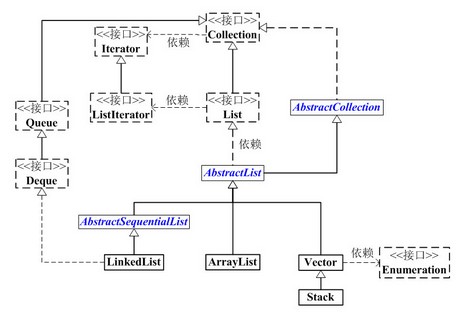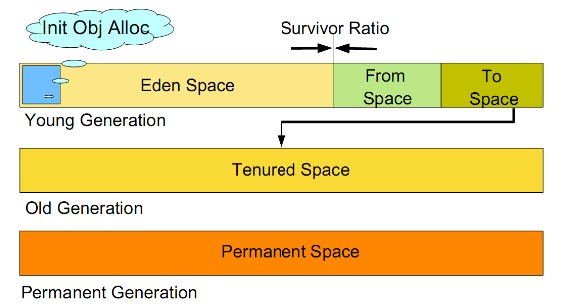第1部分 List概括List的框架图

List 是一个接口,它继承于Collection的接口。它代表着有序的队列。
AbstractList 是一个抽象类,它继承于AbstractCollection。AbstractList实现List接口中除size()、get(int location)之外的函数。
AbstractSequentialList 是一个抽象类,它继承于AbstractList。AbstractSequentialList 实现了“链表中,根据index索引值操作链表的全部函数”。
ArrayList, LinkedList, Vector, Stack是List的4个实现类。
ArrayList 是一个数组队列,相当于动态数组。它由数组实现,随机访问效率高,随机插入、随机删除效率低。
LinkedList 是一个双向链表。它也可以被当作堆栈、队列或双端队列进行操作。LinkedList随机访问效率低,但随机插入、随机删除效率低。
Vector 是矢量队列,和ArrayList一样,它也是一个动态数组,由数组实现。但是ArrayList是非线程安全的,而Vector是线程安全的。
Stack 是栈,它继承于Vector。它的特性是:先进后出(FILO, First In Last Out)。
第2部分 List使用场景学东西的最终目的是为了能够理解、使用它。下面先概括的说明一下各个List的使用场景,后面再分析原因。
如果涉及到“栈”、“队列”、“链表”等操作,应该考虑用List,具体的选择哪个List,根据下面的标准来取舍。
(01) 对于需要快速插入,删除元素,应该使用LinkedList。
(02) 对于需要快速随机访问元素,应该使用ArrayList。
(03)
对于“单线程环境” 或者 “多线程环境,但List仅仅只会被单个线程操作”,此时应该使用非同步的类(如ArrayList)。
对于“多线程环境,且List可能同时被多个线程操作”,此时,应该使用同步的类(如Vector)。
通过下面的测试程序,我们来验证上面的(01)和(02)结论。参考代码如下:
import java.util.*;
import java.lang.Class;
/*
* @desc 对比ArrayList和LinkedList的插入、随机读取效率、删除的效率
*
* @author skywang
*/
public class ListCompareTest {
private static final int COUNT = 100000;
private static LinkedList linkedList = new LinkedList();
private static ArrayList arrayList = new ArrayList();
private static Vector vector = new Vector();
private static Stack stack = new Stack();
public static void main(String[] args) {
// 换行符
System.out.println();
// 插入
insertByPosition(stack) ;
insertByPosition(vector) ;
insertByPosition(linkedList) ;
insertByPosition(arrayList) ;
// 换行符
System.out.println();
// 随机读取
readByPosition(stack);
readByPosition(vector);
readByPosition(linkedList);
readByPosition(arrayList);
// 换行符
System.out.println();
// 删除
deleteByPosition(stack);
deleteByPosition(vector);
deleteByPosition(linkedList);
deleteByPosition(arrayList);
}
// 获取list的名称
private static String getListName(List list) {
if (list instanceof LinkedList) {
return "LinkedList";
} else if (list instanceof ArrayList) {
return "ArrayList";
} else if (list instanceof Stack) {
return "Stack";
} else if (list instanceof Vector) {
return "Vector";
} else {
return "List";
}
}
// 向list的指定位置插入COUNT个元素,并统计时间
private static void insertByPosition(List list) {
long startTime = System.currentTimeMillis();
// 向list的位置0插入COUNT个数
for (int i=0; i
list.add(0, i);
long endTime = System.currentTimeMillis();
long interval = endTime - startTime;
System.out.println(getListName(list) + " : insert "+COUNT+" elements into the 1st position use time:" + interval+" ms");
}
// 从list的指定位置删除COUNT个元素,并统计时间
private static void deleteByPosition(List list) {
long startTime = System.currentTimeMillis();
// 删除list第一个位置元素
for (int i=0; i
list.remove(0);
long endTime = System.currentTimeMillis();
long interval = endTime - startTime;
System.out.println(getListName(list) + " : delete "+COUNT+" elements from the 1st position use time:" + interval+" ms");
}
// 根据position,不断从list中读取元素,并统计时间
private static void readByPosition(List list) {
long startTime = System.currentTimeMillis();
// 读取list元素
for (int i=0; i
list.get(i);
long endTime = System.currentTimeMillis();
long interval = endTime - startTime;
System.out.println(getListName(list) + " : read "+COUNT+" elements by position use time:" + interval+" ms");
}
}
运行结果如下:
Stack : insert 100000 elements into the 1st position use time:1640 ms
Vector : insert 100000 elements into the 1st position use time:1607 ms
LinkedList : insert 100000 elements into the 1st position use time:29 ms
ArrayList : insert 100000 elements into the 1st position use time:1617 ms
Stack : read 100000 elements by position use time:9 ms
Vector : read 100000 elements by position use time:6 ms
LinkedList : read 100000 elements by position use time:10809 ms
ArrayList : read 100000 elements by position use time:5 ms
Stack : delete 100000 elements from the 1st position use time:1916 ms
Vector : delete 100000 elements from the 1st position use time:1910 ms
LinkedList : delete 100000 elements from the 1st position use time:15 ms
ArrayList : delete 100000 elements from the 1st position use time:1909 ms
从中,我们可以发现:
插入10万个元素,LinkedList所花时间最短:29ms。
删除10万个元素,LinkedList所花时间最短:15ms。
遍历10万个元素,LinkedList所花时间最长:10809 ms;而ArrayList、Stack和Vector则相差不多,都只用了几秒。
考虑到Vector是支持同步的,而Stack又是继承于Vector的;因此,得出结论:
(01) 对于需要快速插入,删除元素,应该使用LinkedList。
(02) 对于需要快速随机访问元素,应该使用ArrayList。
(03)
对于“单线程环境” 或者 “多线程环境,但List仅仅只会被单个线程操作”,此时应该使用非同步的类。
第3部分 LinkedList和ArrayList性能差异分析下面我们看看为什么LinkedList中插入元素很快,而ArrayList中插入元素很慢!
LinkedList.java中向指定位置插入元素的代码如下:
// 在index前添加节点,且节点的值为element
public void add(int index, E element) {
addBefore(element, (index==size ? header : entry(index)));
}
// 获取双向链表中指定位置的节点
private Entry entry(int index) {
if (index < 0 || index >= size)
throw new IndexOutOfBoundsException("Index: "+index+
", Size: "+size);
Entry e = header;
// 获取index处的节点。
// 若index < 双向链表长度的1/2,则从前向后查找;
// 否则,从后向前查找。
if (index < (size >> 1)) {
for (int i = 0; i <= index; i++)
e = e.next;
} else {
for (int i = size; i > index; i--)
e = e.previous;
}
return e;
}
// 将节点(节点数据是e)添加到entry节点之前。
private Entry addBefore(E e, Entry entry) {
// 新建节点newEntry,将newEntry插入到节点e之前;并且设置newEntry的数据是e
Entry newEntry = new Entry(e, entry, entry.previous);
// 插入newEntry到链表中
newEntry.previous.next = newEntry;
newEntry.next.previous = newEntry;
size++;
modCount++;
return newEntry;
}
从中,我们可以看出:通过add(int index, E element)向LinkedList插入元素时。先是在双向链表中找到要插入节点的位置index;找到之后,再插入一个新节点。
双向链表查找index位置的节点时,有一个加速动作:若index < 双向链表长度的1/2,则从前向后查找; 否则,从后向前查找。
接着,我们看看ArrayList.java中向指定位置插入元素的代码。如下:
// 将e添加到ArrayList的指定位置
public void add(int index, E element) {
if (index > size || index < 0)
throw new IndexOutOfBoundsException(
"Index: "+index+", Size: "+size);
ensureCapacity(size+1); // Increments modCount!!
System.arraycopy(elementData, index, elementData, index + 1,
size - index);
elementData[index] = element;
size++;
}
ensureCapacity(size+1) 的作用是“确认ArrayList的容量,若容量不够,则增加容量。”
真正耗时的操作是 System.arraycopy(elementData, index, elementData, index + 1, size - index);
Sun JDK包的java/lang/System.java中的arraycopy()声明如下:
public static native void arraycopy(Object src, int srcPos, Object dest, int destPos, int length);
arraycopy()是个JNI函数,它是在JVM中实现的。sunJDK中看不到源码,不过可以在OpenJDK包中看到的源码。网上有对arraycopy()的分析说明,请参考:System.arraycopy源码分析
实际上,我们只需要了解: System.arraycopy(elementData, index, elementData, index + 1, size - index); 会移动index之后所有元素即可。这就意味着,ArrayList的add(int index, E element)函数,会引起index之后所有元素的改变!
通过上面的分析,我们就能理解为什么LinkedList中插入元素很快,而ArrayList中插入元素很慢。
“删除元素”与“插入元素”的原理类似,这里就不再过多说明。
接下来,我们看看 “为什么LinkedList中随机访问很慢,而ArrayList中随机访问很快”。
先看看LinkedList随机访问的代码
// 返回LinkedList指定位置的元素
public E get(int index) {
return entry(index).element;
}
// 获取双向链表中指定位置的节点
private Entry entry(int index) {
if (index < 0 || index >= size)
throw new IndexOutOfBoundsException("Index: "+index+
", Size: "+size);
Entry e = header;
// 获取index处的节点。
// 若index < 双向链表长度的1/2,则从前先后查找;
// 否则,从后向前查找。
if (index < (size >> 1)) {
for (int i = 0; i <= index; i++)
e = e.next;
} else {
for (int i = size; i > index; i--)
e = e.previous;
}
return e;
}
从中,我们可以看出:通过get(int index)获取LinkedList第index个元素时。先是在双向链表中找到要index位置的元素;找到之后再返回。
双向链表查找index位置的节点时,有一个加速动作:若index < 双向链表长度的1/2,则从前向后查找; 否则,从后向前查找。
下面看看ArrayList随机访问的代码
// 获取index位置的元素值
public E get(int index) {
RangeCheck(index);
return (E) elementData[index];
}
private void RangeCheck(int index) {
if (index >= size)
throw new IndexOutOfBoundsException(
"Index: "+index+", Size: "+size);
}
从中,我们可以看出:通过get(int index)获取ArrayList第index个元素时。直接返回数组中index位置的元素,而不需要像LinkedList一样进行查找。
第3部分 Vector和ArrayList比较
相同之处
1 它们都是List
它们都继承于AbstractList,并且实现List接口。
ArrayList和Vector的类定义如下:
// ArrayList的定义
public class ArrayList extends AbstractList
implements List, RandomAccess, Cloneable, java.io.Serializable
// Vector的定义
public class Vector extends AbstractList
implements List, RandomAccess, Cloneable, java.io.Serializable {}
2 它们都实现了RandomAccess和Cloneable接口
实现RandomAccess接口,意味着它们都支持快速随机访问;
实现Cloneable接口,意味着它们能克隆自己。
3 它们都是通过数组实现的,本质上都是动态数组
ArrayList.java中定义数组elementData用于保存元素
// 保存ArrayList中数据的数组
private transient Object[] elementData;
Vector.java中也定义了数组elementData用于保存元素
// 保存Vector中数据的数组
protected Object[] elementData;
4 它们的默认数组容量是10
若创建ArrayList或Vector时,没指定容量大小;则使用默认容量大小10。
ArrayList的默认构造函数如下:
// ArrayList构造函数。默认容量是10。
public ArrayList() {
this(10);
}
Vector的默认构造函数如下:
// Vector构造函数。默认容量是10。
public Vector() {
this(10);
}
5 它们都支持Iterator和listIterator遍历
它们都继承于AbstractList,而AbstractList中分别实现了 “iterator()接口返回Iterator迭代器” 和 “listIterator()返回ListIterator迭代器”。
不同之处
1 线程安全性不一样
ArrayList是非线程安全;
而Vector是线程安全的,它的函数都是synchronized的,即都是支持同步的。
ArrayList适用于单线程,Vector适用于多线程。
2 对序列化支持不同
ArrayList支持序列化,而Vector不支持;即ArrayList有实现java.io.Serializable接口,而Vector没有实现该接口。
3 构造函数个数不同
ArrayList有3个构造函数,而Vector有4个构造函数。Vector除了包括和ArrayList类似的3个构造函数之外,另外的一个构造函数可以指定容量增加系数。
ArrayList的构造函数如下:
// 默认构造函数
ArrayList()
// capacity是ArrayList的默认容量大小。当由于增加数据导致容量不足时,容量会添加上一次容量大小的一半。
ArrayList(int capacity)
// 创建一个包含collection的ArrayList
ArrayList(Collection extends E> collection)
Vector的构造函数如下:
// 默认构造函数
Vector()
// capacity是Vector的默认容量大小。当由于增加数据导致容量增加时,每次容量会增加一倍。
Vector(int capacity)
// 创建一个包含collection的Vector
Vector(Collection extends E> collection)
// capacity是Vector的默认容量大小,capacityIncrement是每次Vector容量增加时的增量值。
Vector(int capacity, int capacityIncrement)
4 容量增加方式不同
逐个添加元素时,若ArrayList容量不足时,“新的容量”=“(原始容量x3)/2 + 1”。
而Vector的容量增长与“增长系数有关”,若指定了“增长系数”,且“增长系数有效(即,大于0)”;那么,每次容量不足时,“新的容量”=“原始容量+增长系数”。若增长系数无效(即,小于/等于0),则“新的容量”=“原始容量 x 2”。
ArrayList中容量增长的主要函数如下:
public void ensureCapacity(int minCapacity) {
// 将“修改统计数”+1
modCount++;
int oldCapacity = elementData.length;
// 若当前容量不足以容纳当前的元素个数,设置 新的容量=“(原始容量x3)/2 + 1”
if (minCapacity > oldCapacity) {
Object oldData[] = elementData;
int newCapacity = (oldCapacity * 3)/2 + 1;
if (newCapacity < minCapacity)
newCapacity = minCapacity;
elementData = Arrays.copyOf(elementData, newCapacity);
}
}
Vector中容量增长的主要函数如下:
private void ensureCapacityHelper(int minCapacity) {
int oldCapacity = elementData.length;
// 当Vector的容量不足以容纳当前的全部元素,增加容量大小。
// 若 容量增量系数>0(即capacityIncrement>0),则将容量增大当capacityIncrement
// 否则,将容量增大一倍。
if (minCapacity > oldCapacity) {
Object[] oldData = elementData;
int newCapacity = (capacityIncrement > 0) ?
(oldCapacity + capacityIncrement) : (oldCapacity * 2);
if (newCapacity < minCapacity) {
newCapacity = minCapacity;
}
elementData = Arrays.copyOf(elementData, newCapacity);
}
}
5 对Enumeration的支持不同。Vector支持通过Enumeration去遍历,而List不支持
Vector中实现Enumeration的代码如下:
public Enumeration elements() {
// 通过匿名类实现Enumeration
return new Enumeration() {
int count = 0;
// 是否存在下一个元素
public boolean hasMoreElements() {
return count < elementCount;
}
// 获取下一个元素
public E nextElement() {
synchronized (Vector.this) {
if (count < elementCount) {
return (E)elementData[count++];
}
}
throw new NoSuchElementException("Vector Enumeration");
}
};
}


